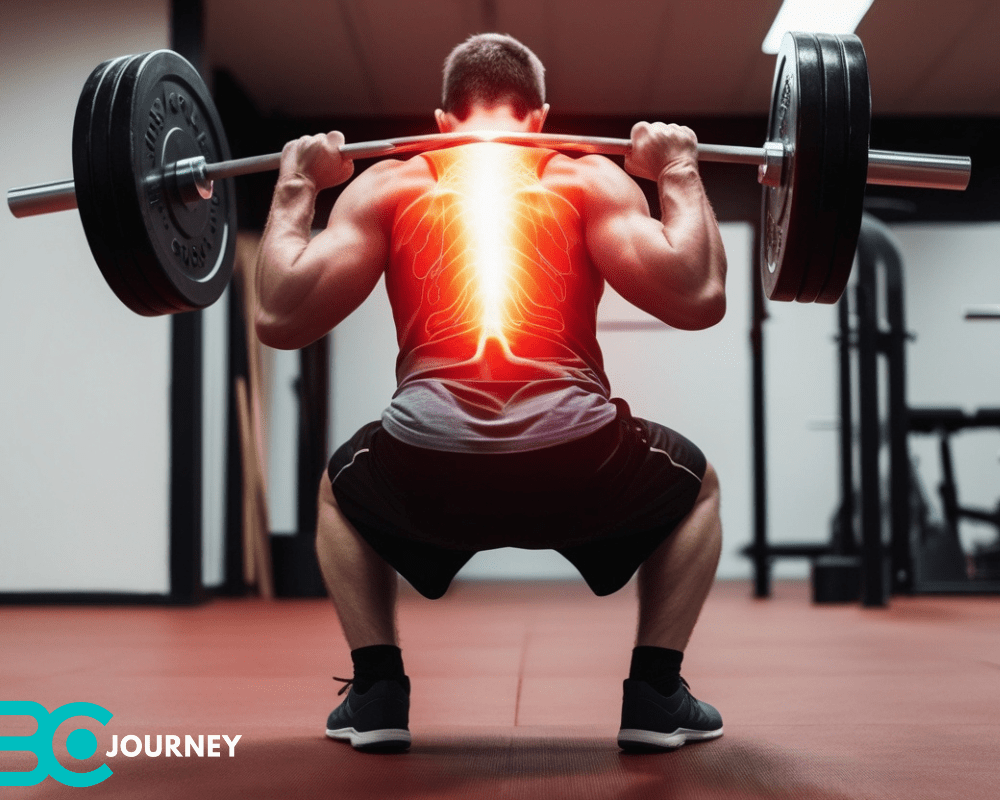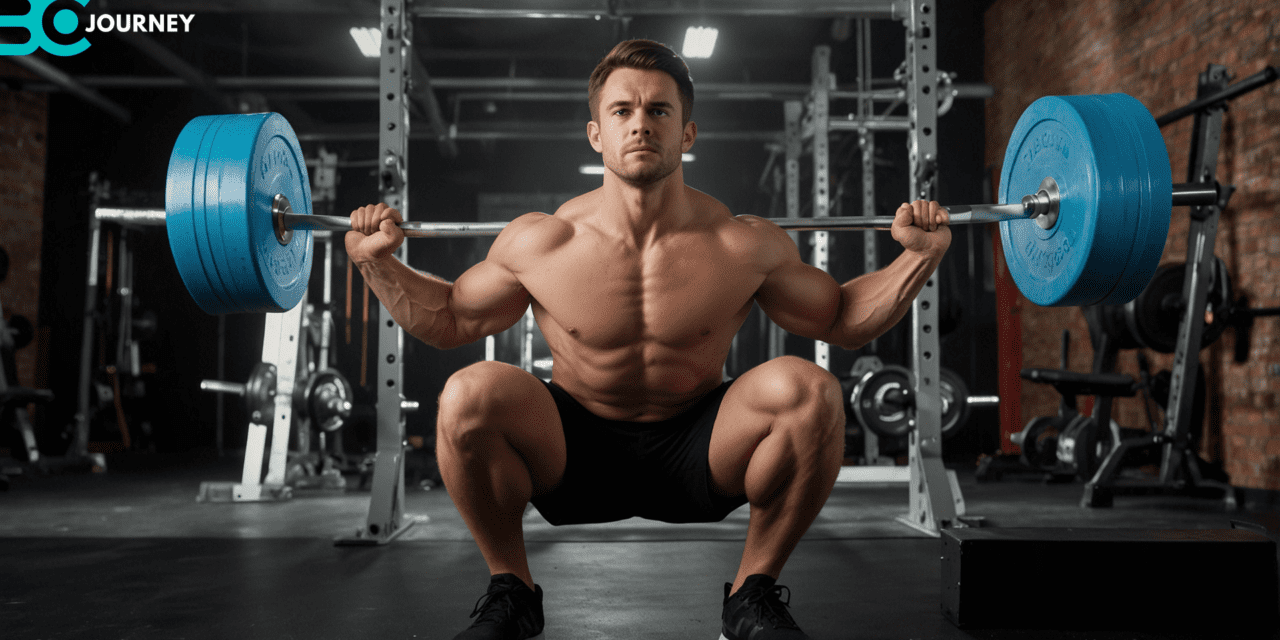How to Fix Back Pain When Squatting: Upper, Middle, and Lower Back Solutions
Squat is one of the most fundamental exercises in fitness that plays a critical role in building strength and stability. Nonetheless, many people are faced with back pain when squatting, which may prevent them from continuing with this important exercise.
Understanding the causes of back pain from squats and how to solve them is very important for anyone who desires to enhance their squat technique and general body fitness. This article will explain the reasons why squat can cause backache in the upper part of your body, middle and lower parts as well as provide methods of avoiding or containing it.
Understanding Upper Back Pain from Squats

Why Does My Upper Back Hurt After Squats?
Most upper back pain during or after squatting is due to barbell placement and excessive tension in the musculature of the rear delts, traps, and neck extensors.
Placing the barbell on top of your shoulders places more load on Your spine, and with a too-narrow grip or high-to-low handles then it just puts even more pressure on that area. This malposition can cause upper trapezius and spine stress which could lead to soft tissue discomfort or pain.
Why Sore Upper Back After Squats?
muscular fatigue is normal after a workout, but soreness in the upper back from squats could suggest an issue with your form or technique. It is extremely important to know the difference between normal soreness and pain- Soreness should go away in a couple of days, whereas Pain will not, and if left unaddressed it could either worsen.
Upper back soreness is often caused by overexerted muscles, especially if these are some of the weaker areas in your body.
How to Fix Upper Back Pain from Squats
Adjusting Barbell Position and Grip
Staying away from upperback stress is oppressive, so you need to get the warmth off your back and load correctly. The bar should rest on the upper trapezius muscles or slightly lower not directly over your spine.
In general, a wider grip on the barbell will help shift some of that weight, lessening tension in your upper back. Keep your elbows pointed down and slightly forward to allow your upper back muscles to form a stable “shelf”.
Strengthening the Upper Back
For squats, it is essential to have strong upper back muscles that can provide support for the barbell. Strengthening exercises such as rows, face pulls, and pull-ups are advised here.
Besides helping lifters hold the barbell securely during squats, a firm upper back increases overall posture and stability while doing them. This will enable you to avoid experiencing soreness or pain in this body region.
Understanding Middle Back Pain from Squats

Middle Back Pain After Squats
Middle back pain during Squats Could Be Due to Several Factors such as Poor Thoracic Mobility, Posture Issues and Muscle Imbalances.
Your thoracic spine to be mobile so that your mid-back rotates position during squats. When the thoracic part of our spine becomes stiff or dysfunctions in somewhere it triggers compensatory movements from lower back causing pain.
How to Fix Middle Back Pain from Squats?
Improving Thoracic Mobility
Improving thoracic spine mobility is necessary for preventing middle back pain. Exercise techniques such as fish pose, foam rolling, and cat-cow stretch can be used to increase the range of motion in this part of the body.
When your thoracic spine is mobile, it enables you to maintain good posture and alignment while performing squats thus reducing middle back pain.
Correcting Posture and Technique
Staying tight throughout the squat movement. Your chest should stay up, and your back flat while doing this exercise. Do not round your back or let shoulders drop too far forward (that will put a little higher load on the middle of your upper back).
Be mindful of keeping your spine in neutral and bracing through the core to assist with this move
Understanding Lower Back Pain from Squats

Why Does Squatting Hurt My Lower Back?
Low back pain as a result of squatting is one of the most frequently articulated complaints by weightlifters. This could be due to factors such as incorrect form during squats, weak core muscles and previous back injuries.
If the lower back rounds at the bottom of the squat (a movement known as “butt wink”), it can place significant stress on the lumbar spine, leading to discomfort or injury.
How to Fix Lower Back Pain from Squats
Correcting Squat Technique
Proper Squat Technique is critical to avoid lower back pain. Start by standing with your feet shoulder width apart and toes facing slightly out. Butt back, hips moving down with the chest going up.
Your knees need to trace over your toes and keep a neutral spine. Also, try not to round your lower back at the bottom of squat so as to prevent any possible involvement with lumbar spine.
Strengthening the Core
For squats, the critical part of your body to keep and stable is a strong core. Planks, dead bugs and bird dogs are your new best friends for building the requisite strength to stabilize your spine. Ensuring that your core is engaged during the squat will help you keep good form and reduce back pain.
Modifying Your Squat Routine
If you have lower back pain from squatting, think about changing up your workouts. For instance, you may want to reduce the amount of weight you’re lifting or try different types of squats like goblet squats or split squats which do not put much strain on the lumbar spine. Additionally, it may be helpful to include rest days in between workouts and focus more on recuperation from exercise if experiencing this kind of discomfort.
Recovery and Prevention of Back pain from squats
How Long Does It Take to Recover from Heavy Squats?
The time to recover from heavy squats will be longer according to the degree of back pain. You can relieve some mild discomfort with rest, stretching, and muscle recovery techniques in a few days.
However, severe cases might take several weeks before they get better or even require medical attention if needed. In case one ignores their body’s signals and continues training through pain it could cause more severe injuries.
What are the Prevention Strategies for Back Pain When Squatting?
So keeping your squats back free is a mixture of correct technique, strength, and range exercises. Before you begin your lift, be sure to warm up to get everything ready for that rep. Ensure that your spine is straight and brace your core during the exercise. Use exercises that work the different muscles of your upper, middle, and lower back, as well as core strength to help fortify you against anything squats can throw at you. Second, do mobility exercises that target your thoracic and hip flexibility since those two are the relevant body parts needed to perform a squat correctly.
Conclusion
Although severe challenges may be posed by back pain from squats in maintaining regular fitness programs, this does not have to be the case. Understanding what causes back pain in each section of your back and then implementing proper technique along with strengthening workouts will let you do squats without experiencing any discomfort at all.
Make sure that whenever you do squats your form is correct; mind yourself if something is wrong with them or even change it for better well-being of your backbone.
Frequently asked questions
If squats are hurting your upper back, you absolutely must examine where the bar is positioned and your grip style. Modifying these positions and strengthening your upper back muscles will help solve the issue. Also, making sure you have a strong upper back to even hold the weight itself is key.
Recovery from heavy squats varies based on the intensity of the workout and the individual’s fitness level. Mild muscle soreness may last a few days, while more significant pain may require a longer recovery period. It’s essential to allow your body enough time to heal before resuming heavy lifting.
Squat as Much You Can! Over time, building up the muscles around your spine, specifically in areas where you might have a weakened core can provide more support and reduce pain.
However, if you have an existing back condition, it’s essential to consult with a healthcare professional before incorporating squats into your routine.
front squats have an altered back demand compared to normal back squats. They do focus more on the quads and upper back, however bad form can cause lower back pain. Proper bar placement on the shoulders and a strong upright torso are critical to avoiding back pain when front squatting,
you should follow some important steps such as rest modifications in form and strengthening exercises. When symptoms are more severe, physical therapy or medical treatment might be needed.
It is also crucial to work on any hidden imbalances or restrictions, such as an asymmetrical strain pattern that could lead to more pain down the road.
If you experience back pain during squats, it may be due to incorrect bar placement or a weak upper spine. Paying attention to form and developing the upper back slowly can help prevent this type of pain.
To relieve back pain due to squats, one should rest and avoid doing things that increase the intensity of this pain. Use a cold pack or heating pad on troubled places to reduce inflammation and alleviate pain.
If you are feeling tight in certain areas, gentle stretching and mobility exercises beyond your normal workout routine may be helpful to remediate muscle tension. If irritation continues, consult a healthcare provider for further evaluation.

